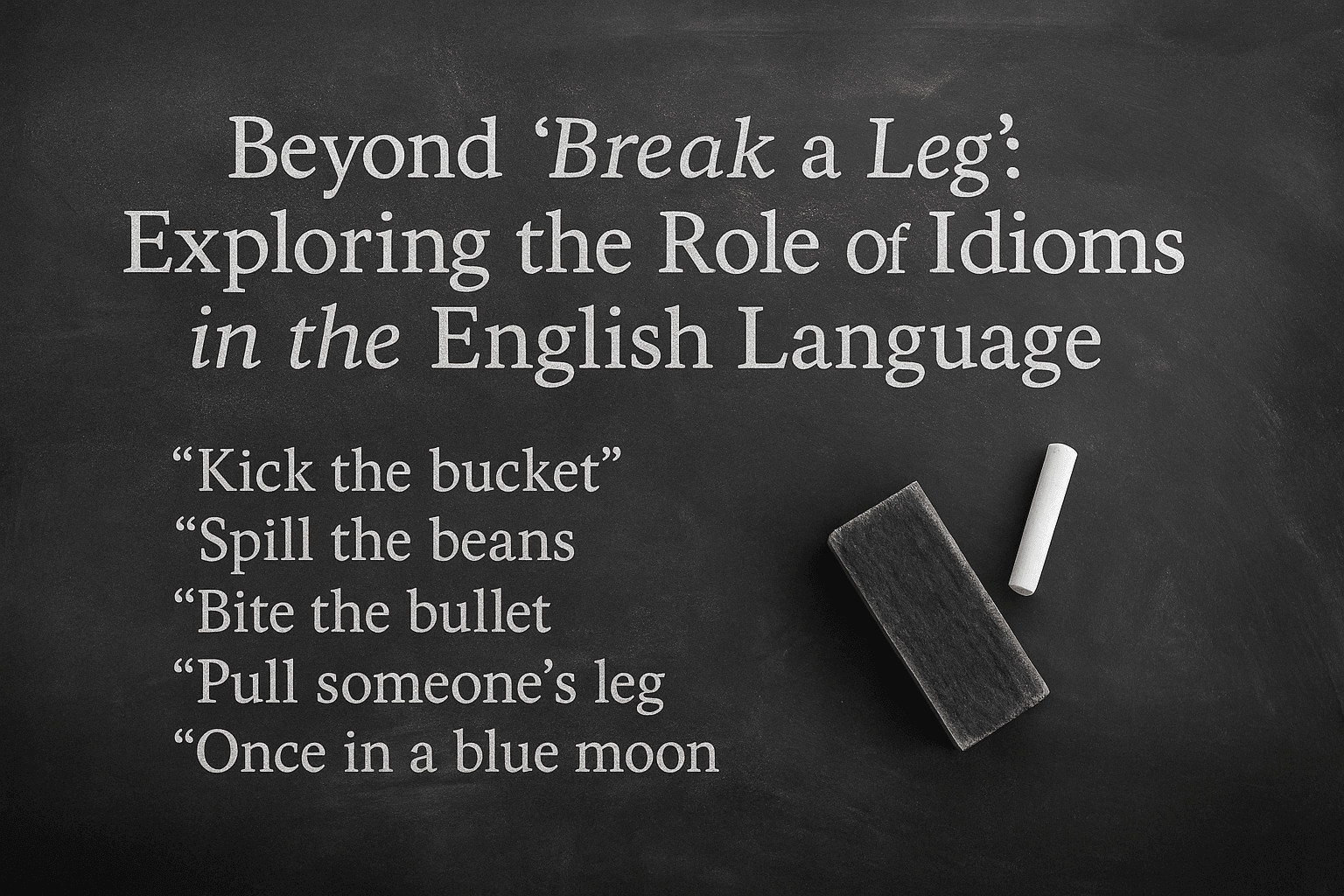Idioms are the heartbeat of any language, adding flavor, humor, and depth to communication. Among the many common idioms in English, the phrase “break a leg” stands out not only for its vivid imagery but also for its cultural richness. Though its literal interpretation may sound violent, the break a leg meaning is actually rooted in superstition and well-wishing—especially in the performing arts.
In this article, we’ll take a broader look at how English idioms like “break a leg” shape communication, connect people across cultures, and reveal the strange and wonderful ways language evolves.
What Exactly Is an Idiom?
Before diving into idioms like “break a leg,” let’s clarify what an idiom actually is. An idiom is a phrase or expression whose meaning can’t be understood literally. Instead, its meaning is derived from cultural or contextual use.
For example:
- “Kick the bucket” doesn’t involve a literal bucket; it means to die.
- “It’s raining cats and dogs” doesn’t mean animals are falling from the sky; it simply means heavy rain.
- “Break a leg” doesn’t encourage harm; it’s a way of wishing someone luck.
Idioms function as shortcuts to meaning, and often convey emotion, tone, or cultural reference far more efficiently than literal language.
Why Idioms Matter in Language
Idioms are crucial to understanding any language fluently. They:
- Express emotion quickly and powerfully
- Convey cultural values or beliefs
- Add humor and personality to speech
- Demonstrate linguistic creativity
- Show a command of informal or colloquial English
In professional, casual, and artistic settings, idioms enrich communication and foster deeper cultural connections.
The Power of “Break a Leg”: A Closer Look
So, why do we say break a leg? As explored in previous articles, the break a leg origin is believed to be tied to superstitions in the performing arts. Saying “good luck” was thought to bring bad luck, so performers flipped the expression into something ironically negative to attract a positive outcome.
But there’s more to the power of this phrase than just superstition.
Community and Belonging
In theater circles, saying “break a leg” becomes a shared ritual. It signals that someone is “in the know,” a part of the performance family. Much like inside jokes or regional slang, idioms build social cohesion.
Language and Identity
The idiom “break a leg” is also an example of how language reflects identity. In this case, it reflects the performer’s mindset: courageous, vulnerable, and superstitious all at once.
Using this phrase signals your familiarity with theatrical norms, your respect for tradition, and your support for fellow performers.
Other Common Idioms That Don’t Make Literal Sense
“Break a leg” isn’t the only idiom that raises eyebrows. Here are several common English idioms with meanings that go far beyond their literal words:
- “Spill the beans” – Reveal a secret
- “Let the cat out of the bag” – Accidentally expose hidden information
- “Bite the bullet” – Endure pain or adversity
- “Pull someone’s leg” – Tease or joke
- “Once in a blue moon” – Very rarely
- “Cut corners” – Do something poorly or cheaply
All of these expressions require cultural knowledge to understand, which is what makes them so fun—and so frustrating—for language learners.
Idioms in English Learning: A Double-Edged Sword
For English as a Second Language (ESL) learners, idioms can be both challenging and rewarding. Here’s why:
The Challenge:
- Idioms often don’t translate well across languages.
- Their meanings are tied to culture, history, or regional use.
- Some idioms are outdated or informal, making them hard to learn from textbooks.
The Reward:
- Understanding idioms shows language fluency.
- Using idioms helps learners sound natural and expressive.
- Idioms reveal cultural richness and offer conversational nuance.
“Break a leg,” for instance, is commonly taught in ESL classes as a fun and culturally rich idiom that opens the door to exploring more idiomatic expressions.
Idioms Across Cultures: Do Other Languages Say “Break a Leg”?
Interestingly, many cultures use ironic or metaphorical phrases to wish someone luck:
- In German, people say “Hals- und Beinbruch” (literally “break your neck and leg”), similar to “break a leg.”
- In Italian, they say “In bocca al lupo” (into the wolf’s mouth), and the response is “Crepi il lupo!” (may the wolf die!).
- In French theater, “Merde!” (yes, that word) is shouted for good luck before a performance.
These examples show that while the expressions vary, the practice of coded well-wishing is universal.
Idioms in Popular Media
Idioms also thrive in music, film, and literature. Think of how many movie titles, song lyrics, or book names use idioms:
- Kick the Bucket List
- Raining Men
- Rolling in the Deep
- Let the Cat Out of the Bag
- Piece of Cake (used in children’s stories and language books)
These expressions are embedded in pop culture, making idioms not just tools of conversation, but also markers of modern storytelling.
Can Idioms Become Outdated?
While idioms enrich the language, some do fade with time. As culture evolves, new idioms emerge while others fall into disuse. For example:
- “A stitch in time saves nine” is rarely heard today.
- “Don’t look a gift horse in the mouth” may confuse younger audiences.
- “Break a leg,” however, has remained strong, especially thanks to the enduring influence of theater and performance culture.
The most successful idioms are those that continue to resonate across generations.
Final Thoughts: Embracing the Magic of Idioms
Idioms are the poetry of everyday language. They give us a way to express complicated emotions, cultural values, and historical context in just a few words. And among them, “break a leg” stands tall as a uniquely vivid and beloved expression.
Whether you’re an actor preparing for a big performance, a student tackling a major exam, or a teacher explaining English expressions to curious learners, “break a leg” remains a powerful phrase of support and tradition.
The break a leg meaning has evolved far beyond its literal interpretation, turning it into a phrase that celebrates risk, courage, and creativity. It has earned its place as one of the most famous English idioms—one that exemplifies how language can surprise, delight, and connect us in ways we never expected.
So, in your next adventure—on stage, in life, or in learning—don’t forget to embrace idioms. And of course, break a leg!




